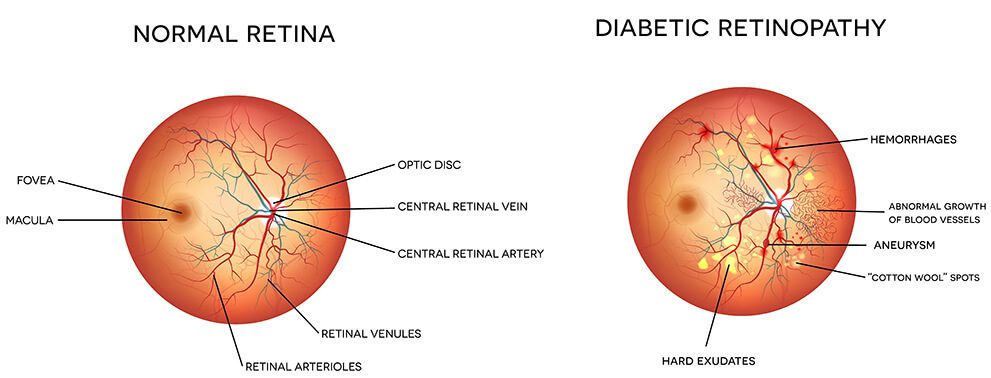Diabetic retinopathy is the most common diabetic eye disease. It consists of damage to the blood vessels in the retina and can cause vision impairment or blindness.

Risk Factors
All people with diabetes are at risk, including Type I (juvenile onset) and Type II diabetes. During pregnancy, diabetic retinopathy may also be a problem for women with diabetes. All pregnant women with diabetes should have dilated eye examinations each trimester to protect their vision.
About 50 percent of people with diabetes will develop diabetic retinopathy during their lifetime.
Prevalence
About 50 percent of people with diabetes will develop diabetic retinopathy during their lifetime. The longer a person has diabetes, the higher the risk to develop diabetic retinopathy.
Vitreous floaters are sometimes seen as threadlike strands in the patient’s visual field. Typically these lines/spots float or drift as the eye moves
Symptoms
Floaters can be a sign of diabetic retinopathy. Sometimes difficulty reading or doing close work can indicate that fluid is collecting in the macula, the most light-sensitive part of the retina.
Treatment
Two treatment options are available; both of which are very effective but do not cure diabetic retinopathy: Laser surgery is performed in a doctor’s office or eye clinic. Before the surgery, your ophthalmologist will dilate your pupil and apply drops to numb the eye. In some cases, the doctor also may numb the area behind the eye to prevent any discomfort. A vitrectomy will be performed whenever laser surgery is deemed inefficient, usually if you have a lot of blood in the vitreous. A vitrectomy involves removing the cloudy vitreous and replacing it with a salt solution. Because the vitreous is mostly composed of water, you won’t notice the difference between the salt solution and the normal vitreous.



April is Sports Eye Safety Month, and we're here to remind you that your eyes deserve protection in all of life's games. Whether you're a professional athlete or a weekend warrior, we have the protective solutions to keep you in the clear. 🏈🕶️ #SportsSafety #protectyoureyes #bennetteyeinstitute #lovelife ... See MoreSee Less
0 CommentsComment on Facebook
In celebration of World Health Day, we're shining a light on the integral role of eye health in your overall wellness. Regular eye exams are key to catching not only vision issues early but can also even be the first sign of other health concerns. Schedule your eye exam at any of our seven locations across the islands. 🌎👁️ #WorldHealthDay #eyeexamessentials #bennetteyeinstitute #lovelife ... See MoreSee Less
0 CommentsComment on Facebook
🌑✨ We're gearing up for an awe-inspiring celestial event - we can view a partial solar eclipse across the islands on April 8th! While it's a rare and exciting moment, it's crucial to protect your eyes. Looking directly at the sun, even during an eclipse, can cause permanent eye damage. Use eclipse glasses that meet the ISO 12312-2 international safety standard, consider pinhole projectors as an alternative method for indirect viewing, and remember, regular sunglasses don’t offer sufficient protection against the sun’s rays during an eclipse. 🌌🔭 #SolarEclipse2024 #EyeSafety #EclipseGlasses #ProtectYourEyes #AstronomicalEvent #BennettEyeInstitute #LoveLife ... See MoreSee Less
0 CommentsComment on Facebook
Think eating carrots is the secret to impeccable vision? Guess again! 🥕 We’re all about eye health, but let’s get one thing straight - our dedication to your vision is no laughing matter. Dive into real eye care with us. 🕶️ #AprilFools #NoJoke #EyeHealthMatters #Bennetteyeinstitute #LoveLife ... See MoreSee Less
0 CommentsComment on Facebook
🐰🌼 Hoppy Easter from our practice to all our wonderful patients! Wishing you a joyful and clear-sighted holiday! 🌸👀 #eyecare #happyeaster #visionhealth #bennetteyeinstitute #lovelife ... See MoreSee Less
0 CommentsComment on Facebook
Wave goodbye to winter and embrace the thrill of spring adventures 🌴✈️! Recent findings from RSC highlight a pivotal insight: 50% of adventurers are held back from fully enjoying activities like water sports due to the inconvenience of glasses or contacts. 😎 🏖️ Plus, a significant 55% agree that having clear, unaided vision could profoundly enhance their travel experiences. How much could clear vision transform your adventures? 🌍💬 #ClearVision #AdventureReady #SpringTravels #rscsurvey #bennetteyeinstitute #lovelife ... See MoreSee Less
0 CommentsComment on Facebook